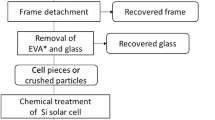Abstract
The removal behavior of the aluminum paste was investigated using thermogravimetric analyzer, and it was found that the mass loss curve could be divided into two main stages including low-temperature and high-temperature stages and a complex transition between them. The pre-exponential factors of the two main stages were calculated by Kissinger method. And the activation energies were determined using different methods named as Flynn–Wall–Ozawa (FWO), Kissinger–Akahira–Sinose (KAS) and Kissinger. The dependence of the activation energy on the conversion has been analyzed in detail. The activation energy of the low-temperature stage keeps approximately constant, and the average value is 38.74 kJ mol−1 of FWO method and 33.86 kJ mol−1 of KAS method. According to KAS method, the activation energy for the high-temperature stage decreases from 157.03 to 94.65 kJ mol−1 with the temperature increasing from 596 to 675 K. The variation range of the activation energies indicates the existence of a complicated reaction mechanism during the high-temperature stage. Though high removal rate during the low-temperature stage is beneficial to reducing the processing time of silicon solar cells, the heating rate should be controlled when the temperature is close to the value resulting in the maximum mass loss rate to avoid causing defects in the aluminum back electrode.







Similar content being viewed by others
References
Zwaan B, Rabl A. Prospects for PV: a learning curve analysis. Sol Energy. 2003;74:19–31.
Zhao BX, Zhou JC, Chen YM. Numerical simulation of the impurity photovoltaic effect in silicon solar cells doped with thallium. Phys B Condens Matter. 2010;405:3834–7.
Park S, Park H, Kang Y, et al. Analysis of aluminum back surface field at different wafer specifications in crystalline silicon solar cells. Curr Appl Phys. 2016;16:1062–8.
Ali K, Khan SA, Jafri MZM. Enhancement of silicon solar cell efficiency by using back surface field in comparison of different antireflective coatings. Sol Energy. 2014;101:1–7.
Zhou JC, Chen X, Zhao BX, et al. Influence of glass frits on the formation of back surface field in silicon solar cell. Mater Lett. 2016;169:197–9.
Jang HY, Hye YK, Jung HK, et al. Characteristics of Pb-based glass powders prepared by spray pyrolysis as inorganic additive of Al paste for solar cell. Sol Energy Mater Sol Cells. 2011;95:34–8.
Lin HW, Chang CP, et al. The rheological behaviors of screen-printing pastes. J Mater Process Technol. 2008;197:284–91.
Gan WP, Xiong ZJ, Luo L, et al. Investigation of effect of the organic vehicle on performance of front silver paste for solar cell. New Chem Mater. 2014;42:141–4.
Balucani M, Serenelli L, Kholostov K, et al. Aluminum–silicon interdiffusion in screen printed metal contacts for silicon based solar cells applications. Energy Procedia. 2013;43:100–10.
Krause J, Woehl R, Rauer M, et al. Microstructural and electrical properties of different-sized aluminum-alloyed contacts and their layer system on silicon surfaces. Sol Energy Mater Sol Cells. 2011;95:2151–60.
Park S, Song J, et al. Investigation of Al back contacts and BSF formation by in situ TEM for silicon solar cells. Prog Photovolt Res Appl. 2014;22:863–9.
Popovich VA, Janssen M, et al. Microstructure and mechanical properties of aluminum back contact layers. Sol Energy Mater Sol Cells. 2011;95:93–6.
Xi X, Chen XJ, Zhang S, et al. The investigation on the stratification phenomenon of aluminum rear alloyed layer in silicon solar cells. Appl Surf Sci. 2015;339:116–21.
Vinodh S, Jessen C, Ankit K, et al. Optimisation of screen-printed metallisation for industrial high-efficiency silicon wafer solar cells. Energy Procedia. 2013;33:64–9.
Ebong A, Brody J, et al. Optimization of front metal contact firing scheme to achieve high fill factors on screen printed silicon solar cells. Sol Energy Mater Sol Cells. 2001;65:613–4.
Rauer M, Schmiga C, Tuschinsky A, et al. Investigation of aluminum–boron doping profiles formed by coalloying from screen-printed pastes. Energy Procedia. 2013;43:93–9.
Gu X, Yu XG, Yang D. Efficiency improvement of crystalline silicon solar cells with a back-surface field produced by boron and aluminum co-doping. Scr Mater. 2012;66:394–7.
Yoon PY, Chung H, et al. Investigation of the controlling parameters on the bowing phenomenon in ultra-thin crystalline silicon solar cells. Appl Therm Eng. 2015;90:559–70.
Lai CM, Su CH, Lin KM. Analysis of the thermal stress and warpage induced by soldering in monocrystalline silicon cells. Appl Therm Eng. 2013;55:7–16.
Yoon PY, Baek T, et al. Numerical simulation of bowing phenomenon in ultra-thin crystalline silicon solar cells. Sol Energy. 2014;105:705–14.
Martin MA, Blázquez G, Zamora MC, Calero M. Kinetic modelling of torrefaction of olive tree pruning. Appl Therm Eng. 2017;113:1410–8.
Elém PAR, Ekaterina S, Esa V, et al. Kinetics of pyrolysis of some biomasses widely available in Brazil. J Therm Anal Calorim. 2017;130:1545–54.
Flynn JH. The isoconversional method for determination of energy of activation at constant heating rates. J Therm Anal. 1983;27:95–102.
Ozawa T. A new method of analyzing thermogravimetric data. B Chem Soc Jpn. 1965;38:1881–6.
Kissinger HE. Reaction kinetics in differential thermal analysis. Anal Chem. 1957;29:1702–6.
Akahira T, Sunose T. Method of determining activation deterioration constant of electrical insulating materials. Res Rep Chiba Inst Technol. 1971;16:22–31.
Kissinger H. Variation of peak temperature with heating rate in differential thermal analysis. J Res Nat Bur Stand. 1956;57:217–21.
Doyle CD. Estimating isothermal life from thermogravimetric data. J Appl Polym Sci. 1962;6:639–42.
Coats AW, Redfern JP. Kinetic parameters from thermogravimetric data. Nature. 1964;201:68–9.
Acknowledgements
This work was partially supported by the Fundamental Research Funds for the Central Universities (Grant No. 2017zzts460) and the Science and Technology Project of Changsha (Grant No. k1403017-11).
Author information
Authors and Affiliations
Corresponding author
Additional information
Publisher's Note
Springer Nature remains neutral with regard to jurisdictional claims in published maps and institutional affiliations.
Rights and permissions
About this article
Cite this article
Zhou, J., Chen, X. On the removal behavior of aluminum paste for silicon solar cell. J Therm Anal Calorim 137, 1961–1967 (2019). https://doi.org/10.1007/s10973-019-08052-8
Received:
Accepted:
Published:
Issue Date:
DOI: https://doi.org/10.1007/s10973-019-08052-8



